|
Today in New Orleans History |
|
|
August 27


 To receive an update for each day in New Orleans history,
join our facebook page - Today in New
Orleans History.
In
a September 26, 2005 hearing, former FEMA chief Michael Brown testified before a U.S. House subcommittee about FEMA's emergency
response. During that hearing, Representative Stephen Buyer (Republican from Indiana) inquired as to why President Bush's
declaration of state of emergency of August 27 had not included the coastal parishes of Orleans, Jefferson, and Plaquemines.
Brown testified that this was because Louisiana Governor Kathleen Blanco had not included those parishes in her initial request
for aid, a decision that he found "shocking". After the hearing, Blanco released a copy of her letter, which
showed she had requested assistance for "all the southeastern parishes including the City of New Orleans" as well
specifically naming 14 parishes including Jefferson, Orleans and Plaquemines.  To receive an update for each day in New Orleans
history, join our facebook page
- Today in New Orleans History
The Beginning of Preservation Hall The Preservation Hall Jazz Band was awarded the 2006 National
Medal of Arts, the nation’s highest honor for artistic excellence. The award was presented to creative director of
Preservation Hall, Benjamin Jaffe and co-founder of Preservation Hall, Sandra Jaffe, who accepted the award from President
and Mrs. Laura Bush in an Oval Office ceremony on November 9, 2006. The citation reads: “With enormous
talent and pride, this ageless ensemble has toured the world displaying the unbreakable spirit of New Orleans and sharing
the joy of New Orleans jazz with us all". Established in 1961 with the purpose "to preserve, perpetuate, and protect
traditional New Orleans Jazz", its musicians have done so for more than half a century in one of the oldest buildings
in the French Quarter, and around the world. The first record of the property on which the building was constructed
dates to January 1, 1722 when Manrolle de Cas was granted the land. A large fire destroyed an original building there, as
well as the famous Orleans Ballroom (now Royal Orleans Hotel), in 1816. On Tuesday, November 18th 1817, Joseph Guillot
and Claude Gurlie sold the property on which the two-story brick building is located to Agathe Fanchon, a femme de couleur
libre (free woman of color), for $13,500. Around the turn of the century it was used as the residence of Dr. Eugene Rabasse and Joseph
Oreda's tin shop. During the 1920s it was the home and photography studio of Mr. and Mrs. Will H. Moses (Mrs. Moses
continued to live there and operated the studio long after her husband's death. In 1925 the building, which was described
the the local newspaper as "one of the most delightful of those on the block at present to be the center of development".
was remodelled by S. J. Shwartz, owner of Maison Blanche (see October 30). In 1927 resident Mrs.
Orme Grey, president of the Vieux Carre Million Club, caused a stir when she submitted names to the Times-Picayune of people
who apparently were having a great time on the same block where Pat O'Brien's bar would later call home; an outraged club
member made it known that her peers "deplore vice conditions in the Vieux Carre. Persons of social standing in
New Orleans contribute by renting studios in the Old Quarter for purposes of giving wild parties". During
the 1930s, if not earlier, photographer Wood "Pops" Whitesell and architect Arthur Feitell moved there. During
the 1950s a part of the building was used as an art gallery named Associated Artists which was managed by E. Lorentz (Larry)
Borenstein. In January 1984, Sandra and Allan Jaffe (founders of Preservation Hall) bought the building for $600,000. It has been said
that Borenstein hosted many prior jazz sessions at 726 St. Peter, and from these evolved what we now know as Preservation
Hall which officially opened its doors in 1961. Allan and Sandra Jaffe, the hall's founders, sought to keep traditional
New Orleans jazz, played by New Orleans natives, alive during an era when venues for the historic craft were few and far between.
They hired George Lewis, Punch Miller, Sweet Emma Barrett, Billie and De De Pierce, The Humphrey Brothers, and dozens more,
and payed them at or above the normal rates. In 1963, Jaffe organized a tour of the newly minted
Preservation Hall Jazz Band in the Midwest. This band was manned essentially the Kid Thomas Band (Kid Thomas Valentine,
George Lewis, Louis Nelson, Emanuel Paul, Joe James, Joe “Twat” Butler, and Sammy Penn -- all of whom had played
in New Orleans during the birth of the art-form. Through the years the band has performed at Carnegie Hall, The Kennedy, The
Hollywood Bowl, the United Nations, and have toured in Europe and Japan (featuring the George Lewis Band). The
first of several recording by the hall's musicians was Sweet Emma and Her Preservation Hall Jazz Band. During Preservation
Hall's 50 anniversary year the band played to a sold-out audience at Carnegie Hall. "Preservation
Hall. Now that's where you'll find all of the greats." said Louis Armstrong. |
|
|

To receive an update for each day in New Orleans history,
join our facebook page - Today in New
Orleans History.
Analytics |
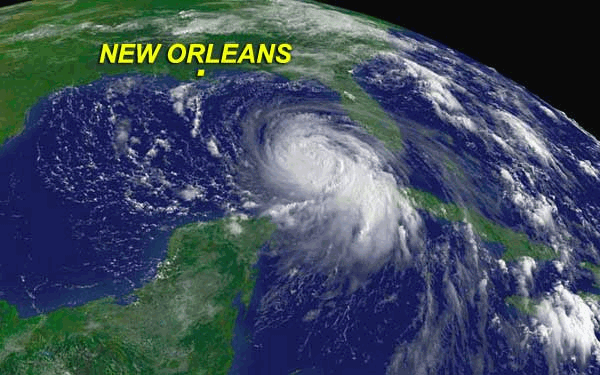
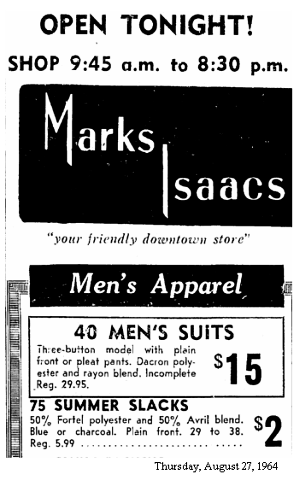
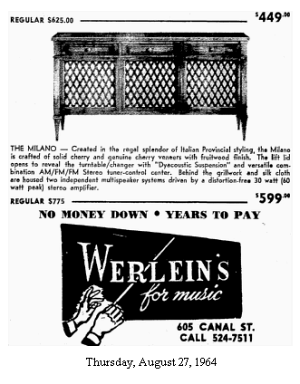
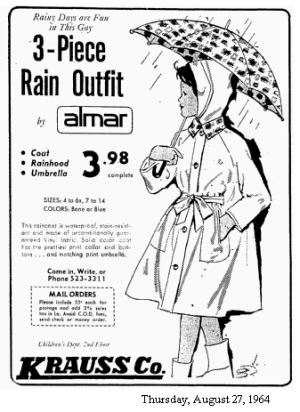 Times-Picayune advertisement for Krauss Company, Canal Street.
Times-Picayune advertisement for Krauss Company, Canal Street.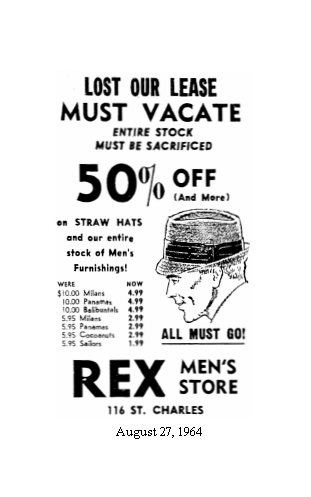
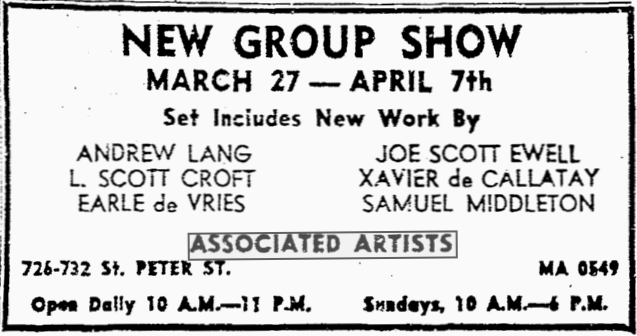
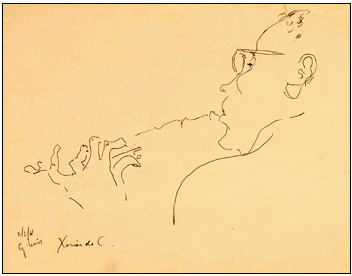 On August 27, 1961, a one-man show of Xavier de Callatay's work included, according to an article in the
Times-Picayune on that same date, "an informal jazz concert" during the reception which was held from 2 to 5 p.m.
at 730 St. Peter (Borenstein's next-door property). This drawing by Callatay was executed in 1961, might have appeared
at the historic August showing, and now resides in the Ogden Museum of Southern Art. It depicts George Lewis, one of
the first musicians to play at Borensteins Associated Artists gallery.
On August 27, 1961, a one-man show of Xavier de Callatay's work included, according to an article in the
Times-Picayune on that same date, "an informal jazz concert" during the reception which was held from 2 to 5 p.m.
at 730 St. Peter (Borenstein's next-door property). This drawing by Callatay was executed in 1961, might have appeared
at the historic August showing, and now resides in the Ogden Museum of Southern Art. It depicts George Lewis, one of
the first musicians to play at Borensteins Associated Artists gallery. 
